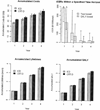Cost-effectiveness of cardiac resynchronization therapy in the MADIT-CRT trial
- PMID: 22913474
- PMCID: PMC3711178
- DOI: 10.1111/j.1540-8167.2012.02413.x
Cost-effectiveness of cardiac resynchronization therapy in the MADIT-CRT trial
Abstract
Background: The Multicenter Automatic Defibrillator Implantation Trial-Cardiac Resynchronization Therapy (MADIT-CRT) trial demonstrated that cardiac resynchronization therapy (CRT) when added to the implantable cardiac defibrillator (ICD) reduces risk of heart failure or death in minimally symptomatic patients with reduced cardiac ejection fraction and wide QRS complex.
Objectives: To evaluate 4-year cost-effectiveness of CRT-ICD compared to ICD alone using MADIT-CRT data.
Research design: Patients enrolled in the trial were randomized to implantation of either ICD or CRT-ICD in a 2:3 ratio, with up to 4-year follow-up period. Cost-effectiveness analyses were conducted, and sensitivity analyses by age, gender, and left bundle branch block (LBBB) conduction pattern were performed.
Subjects: A total of 1,271 patients with ICD or CRT-ICD (US centers only) who reported healthcare utilization and health-related quality of life data.
Measures: We used the EQ-5D (US weights) to assess patient HRQOL and translated utilization data to costs using national Medicare reimbursement rates.
Results: Average 4-year healthcare expenditures in CRT-ICD patients were higher than costs of ICD patients ($62,600 vs 57,050, P = 0.015), mainly due to the device and implant-related costs. The incremental cost-effectiveness ratio of CRT-ICD compared to ICD was $58,330/quality-adjusted life years (QALY) saved. The cost effectiveness improved with longer time horizon and for the LBBB subgroup ($7,320/QALY), with no cost-effectiveness benefit being evident in the non-LBBB group.
Conclusions: In minimally symptomatic patients with low ejection fraction and LBBB, CRT-ICD is cost effective within 4-year horizon when compared to ICD-only.
© 2012 Wiley Periodicals, Inc.
Figures



Comment in
-
Perspective on cost-effective utilization of cardiac resynchronization therapy.J Cardiovasc Electrophysiol. 2013 Jan;24(1):75-6. doi: 10.1111/jce.12007. Epub 2012 Nov 6. J Cardiovasc Electrophysiol. 2013. PMID: 23131045 No abstract available.
References
-
- Jessup M, Abraham WT, Casey DE, Feldman AM, Francis GS, Ganiats TG, Konstam MA, Mancini DM, Rahko PS, Silver MA, Stevenson LW, Yancy CW. ACCF/AHA guidelines for the diagnosis and management of heart failure in adults: A report of the American College of Cardiology Foundation/American Heart Association task force on practice guidelines: Developed in collaboration with the international society for heart and lung transplantation. Circulation. 2009;119:1977–2016. - PubMed
-
- Bristow MR, Saxon LA, Boehmer J, Krueger S, Kass DA, De Marco T, Carson P, DiCarlo L, DeMets D, White BG, DeVries DW, Feldman AM. Comparison of Medical Therapy, Pacing, and Defibrillation in Heart Failure (COMPANION) Investigators. Cardiac-resynchronization therapy with or without an implantable defibrillator in advanced chronic heart failure. N Eng J Med. 2004;350:2140–2150. - PubMed
-
- Cleland JG, Daubert JC, Erdmann E, Freemantle N, Gras D, Kappenberger L, Tavazzi L. Cardiac Resynchronization-Heart Failure (CARE-HF) Study Investigators. The effect of cardiac resynchronization on morbidity and mortality in heart failure. N Eng J Med. 2005;352:1539–1549. - PubMed
-
- Linde C, Mealing S, Hawkins N, Eaton J, Brown B, Daubert J. Cost-effectiveness of cardiac resynchronization therapy in patients with asymptomatic to mild heart failure: insights from the European cohort of the REVERSE (Resynchronization Reverses remodeling in Systolic Left Ventricular Dysfunction) Eur Heart J. 2011;32(13):1631–1639. - PubMed
-
- Moss AJ, Hall WJ, Cannom DS, Klein H, Brown MW, Daubert JP, Estes M, Foster E, Greenberg H, Higgins SL, Pfeffer MA, Solomon SD, Wilber D, Zareba W for the MADIT-CRT Trial Investigators. Cardiac resynchronization therapy for the prevention of heart failure events. N Eng J Med. 2009;361:1329–1338. - PubMed
Publication types
MeSH terms
Grants and funding
LinkOut - more resources
Full Text Sources
Medical
Research Materials

